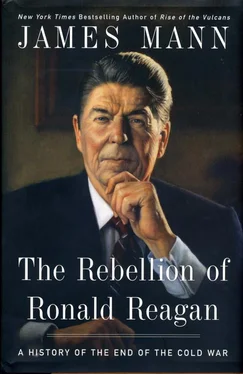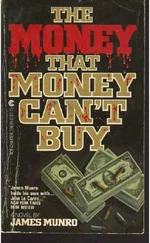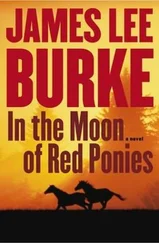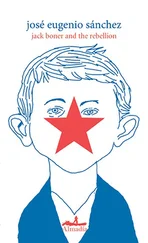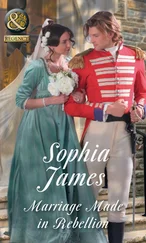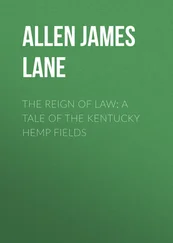Reagan countered two weeks later, on January 16, 1984, with a speech about the Soviet Union that was strikingly conciliatory in tone. It marked a distinct change in emphasis from his public statements of the previous three years. In his Westminster speech in 1982, Reagan had relegated the communist system to the “ash heap of history,” and the following year, he had denounced the Soviet regime as “the evil empire.” This time, however, the president emphasized the importance of reducing the possibility of confrontation between the two countries. “Neither we nor the Soviet Union can wish away the differences between our two societies and our philosophies,” Reagan declared, “but we should always remember that we do have common interests and the foremost among them is to avoid war and reduce the level of arms.” 15
Reagan had instructed his aides several weeks earlier to prepare a speech that could launch a concerted attempt at new discussions with Moscow in 1984. The speech had been ready before the end of December but had been delayed until January at the request of Nancy Reagan, in consultation with her astrologer, Joan Quigley. Most of the speech had been drafted by Jack Matlock, then the National Security Council aide for Soviet affairs, and by State Department officials. However, Reagan himself wrote the final section of the speech, which cast the abstract idea of common interests between the United States and the Soviet Union in his own distinctive style, a sentimental appeal to ordinary, unsophisticated Americans:
Just suppose with me for a moment that an Ivan and an Anya could find themselves, oh, say, in a waiting room, or sharing a shelter from the rain or a storm, with a Jim and Sally, and there was no language barrier to keep them from getting acquainted. Would they then debate the differences between their respective governments? Or would they find themselves comparing notes about their children and what each other did for a living? Before they parted company, they would probably have touched on ambitions and hobbies and what they wanted for their children and problems of making ends meet. And as they went their separate ways, maybe Anya would be saying to Ivan: ‘Wasn’t she nice? She also teaches music.’ …They might even have decided they were all going to get together for dinner some evening soon. Above all, they would have proven that people don’t make wars. 16
The passage was implausible, old-fashioned, and saccharine. According to Matlock, what Reagan had first written had to be revised, because it was also sexist: in Reagan’s draft, Ivan and Jim talked about their work while Anya and Sally swapped notes about children and cooking. 17Nevertheless, giving the speech signified that Reagan was for the first time seeking public support in America for the idea of easing hostilities with the Soviet Union. At the time, Soviet officials dismissed the overture as a political stunt. “At any other time, such a speech by an American president would have been regarded as a tangible step toward improving relations with the Soviet Union,” reflected Dobrynin many years later. “But with all the other negative factors, to say nothing of the imminent presidential election, it was hard to believe in Reagan’s sincerity.” 18
The National Security Council decided to take Massie up on her suggestion that she return to Moscow as an informal intermediary. The hope was that she might be able to help in obtaining a resumption of cultural exchanges between the United States and the Soviet Union, a first step toward an easing of the broader tensions. A plausible case could be made for sending Massie, who had written a book on Russian culture.
From the Reagan administration’s standpoint, there were several advantages to using Massie in this fashion. She was not an official representative of the U.S. government and thus could not be besieged by the Soviets with demands to justify all of the Reagan administration’s actions and utterances of the previous three years. If the Reagan White House had itself proposed a resumption of cultural exchanges, the Soviets would probably have dismissed the idea as a ruse to divert attention from the recent deployment of Pershing missiles in Europe. Moreover, through Massie and her unofficial contacts in Moscow, the Reagan administration was hoping to circumvent the two senior Soviet officials who had regularly dominated all decisions about the United States: Anatoly Dobrynin, the ambassador to Washington, and his boss, Andrei Gromyko, the foreign minister. “We didn’t want everything to go through Dobrynin,” said Jack Matlock, the NSC’s Soviet expert, who felt both Gromyko and Dobrynin would be cold to the idea of resuming contacts. 1
Sending a private citizen like Massie was irregular, but Robert McFarlane, Reagan’s national security adviser, had a penchant for doing business with other governments outside regular channels. He had learned about the conduct of American foreign policy as a military aide to Henry Kissinger, at a time when Kissinger, as national security adviser, was keeping the State Department, even the secretary of state, in the dark about the Nixon administration’s diplomacy with the Soviet Union, China, and North Vietnam. McFarlane’s own clumsy attempts at Kissingerian secret diplomacy would eventually culminate in the Reagan administration’s biggest disaster, the Iran-Contra scandal, when McFarlane tried to go outside the U.S. government bureaucracy to deal with the leadership in Tehran.
Massie was not Reagan’s only conduit for back-channel discussions with Moscow. During this same period, the administration also received an offer of help from an unlikely source: Senator Edward Kennedy, Democrat from Massachusetts, one of the administration’s most prominent critics. One of Kennedy’s aides, Dr. Lawrence Horowitz, had been meeting in Moscow with Vadim Zagladin, deputy chief of the Communist Party Central Committee’s International Department. For several years, Horowitz served as a secret message carrier between Reagan’s NSC and Zagladin. Kennedy was aware of these secret exchanges; for a long time Secretary of State George Shultz was not. 2
At one juncture, McFarlane also sought to have Reagan designate Brent Scowcroft, the former national security adviser and onetime aide to Kissinger, as an emissary for private conversations with top Soviet leaders. But soon after McFarlane broached the idea with Reagan and invited Scowcroft to come to the White House to discuss the mission, Shultz passionately objected, arguing that all Soviet diplomacy should go through him and the State Department. Reagan knew how to handle turf battles like this one in a genial, nonconfrontational way. When Scowcroft arrived at the White House a few days later to talk in further detail about what he should say on Reagan’s behalf on an upcoming visit to Moscow, Reagan told him stories about the movie Patton for twenty minutes: how the movie was made, why Patton’s speech was in the beginning of the film. The president then stood up and said, “Well, good luck!”—thus leaving Scowcroft bewildered, Shultz mollified, and McFarlane not really humiliated. 3
Massie, who had never served in government, was a different sort of intermediary from Scowcroft. She was not being sent to meet with top Soviet leaders; she was being asked to explore merely routine cultural exchanges, not major diplomatic issues such as arms control. Still, Massie moved quickly and shrewdly to enhance her status. Before leaving for Moscow on the cultural mission for the NSC, Massie said she had a single request. She wanted to meet, face-to-face, with Reagan. She argued that it would be important to be able to tell Soviet officials that she had met with the president and that what she was saying had his personal imprimatur. 4
Читать дальше
